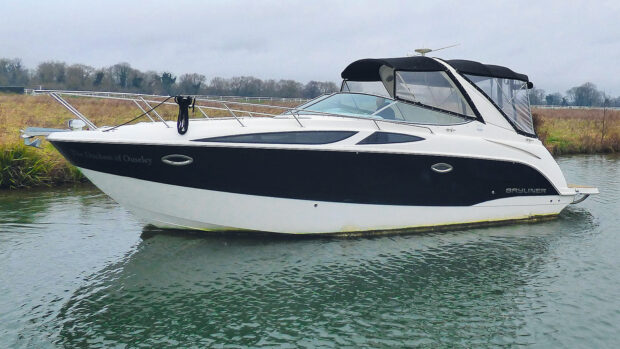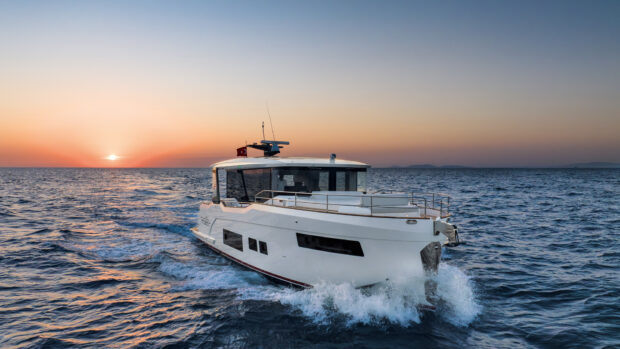Sunseeker have conjured well to produce their gorgeous 82-footer. The deck saloon seems to come from a bigger boat, while its lively performance is what you expect of something much smaller
There was something I couldn’t quite put my finger on when I first went aboard the Sunseeker 82 Yacht at the Southampton Boat Show.
The main deck seemed surprisingly spacious, and I couldn’t work out how the designers had done it. They had clearly not skimped on the galley, which seemed to me to be of class-leader proportions and rather well laid out.
The saloon seating was more than adequate for an eight-berth motor yacht.
Moreover, it was arranged around a series of cleverly unorthodox angles that didn’t seem to have been conceived out of an urge to save space – quite the opposite, if anything.
Yet still the area flowed well and you wouldn’t be forever tripping over each other’s feet. The dining table was a true eight-seater, but it had room to breathe and, just as important, there was plenty of access all round.

Dining in style: room for you and seven guests.
Up forward, the helm position’s pair of adjustable leather seats were mounted independently, with access each side but still well clear of the side door – while across to port, there was a big comfy sofa at the navigator’s station, a huge chart area, and an excellent view out of the windows.
It was here that I sat, dumbly pondering the mysteries of time and space – mainly space – like a fully articulated but very much less clever Stephen Hawking.
Although different in some ways from an infinitely expanding universe, the main deck layout of the Sunseeker 82 Yacht nevertheless seemed a bit too big like it had been stolen from a 95. How did they get it all in?

The stairless saloon is dreamily spacious.
Seeing my bemusement, a helpful salesman stepped in. “There’s no stairs;’ he said. Of course – the stairs up to the flybridge.
They usually crowd the galley, or loom over one of the sofas, or block out light from the windows, or all three. And because they’re big and obtrusive and get in the way, designers hate them.
They try to render them invisible, by refusing to provide a handrail, or insisting the steps are made of glass, or by making them impossibly steep, or all three – with the result that anyone who lacks the head of a trapeze artist and the feet of a gecko learns to ignore them, and uses the steps in the cockpit instead.
As eureka moments go it might not have been in the Hawking class, but nevertheless everything did suddenly make a bit more sense.
There might even have been a bit of a eureka moment in the design office too, even though with hindsight the decision was a no-brainer: “These steps that get in the way, and that no one uses. Do we really- erm – need them?”

Driving ambition – the Sunseeker 82 Yacht’s well appointed helm.
The benefits extend up top too, as no stairs intruding forward means no restrictions on where you put the upper helm station, or how big it can be. Inevitably, one wonders why they didn’t do it before.
Many months elapsed after that boat show before I was able to take a Sunseeker 82 Yacht out on test, but when the time came, I found that the missing inside staircase was not the only surprise in store.
In Poole Harbour the boat was a pussycat, thanks in part to the low-speed switch that chops the idle speed of the twin Cats by 100rpm to a mere 550rpm, reducing boat speed to around six knots.
The fiveblade props bite just as well in reverse as ahead, so manoeuvring is simple on throttles alone.
The hydraulic bow and stern thrusters both work off the port engine, and so can only be used singly but they are hardly necessary anyway.
This was all pleasant enough to discover, but the second eureka moment came when we cleared the buoyed channel and headed for open water to see what the Sunseeker 82 could do.
The air still bore the chill of early spring, and once out of the lee of Old Harry the wind picked up to about a Force 4, over a fairly benign 2-3ft chop.
It turned out that the Sunseeker 82 will do pretty much whatever you ask of it – for this is a 55-tonner that thinks it’s a raceboat.
Crank the helm hard over on most motor yachts this size and you’re not too surprised to find it behaving like the Ark Royal.
For a while, nothing much may happen – which is fine. Vessels in this class are supposed to deport themselves with decorum.
Hooliganism at the helm upsets the flower arrangements and causes guests to fall off their stilettos.
But crank the helm right over on the Sunseeker 82 Yacht, and you will be extremely surprised to find it behaving like an outdrive 30-footer.
Roll response – there’s no other way to describe it – is immediate, the hull banking hard while the helmsman finds himself looking thoughtfully straight down at rushing water as the chine digs in and hauls the boat round.
I would estimate the turning circle to be no more than four boat lengths. On a 55-tonne boat. At 30 knots.
Once you’ve done this for the first time you have to do it again right away, just to see if it was a fluke. It wasn’t.
Then you have to do it the other way, to see if it – well, to see if it does it the other way, and then you have to do it another 15 or 20 times to see if familiarity makes it any less fun, and when you discover that it doesn’t you look round to find that your guests are gripping their drinks a little too tightly and staring at you, and so you cough and redden slightly and resume a steady course, because motor yachts in this class are supposed to be handled with a certain restraint.
In a straight line, too, the ride was firm and sure-footed. In the light chop I faced the hull couldn’t be faulted, whether downwind, upwind or beam on, and the instant helm response would be confidence-inspiring – fun, even – when picking out a path through big seas.
A capable sea boat then, and an extraordinarily good drive – the Sunseeker 82 is full of surprises. It is also offered with a surprising variety of layouts.

Owner’s rights: looking to starboard in the amidships master cabin.
At that Southampton show, boat No. 1 was exhibited with the standard design (as shown here), with a superb master cabin layout and a central walkaround bed.
This was without doubt the right layout to take to a boat show, but having the owner’s heads on the port side robs a lot of space from the fourth cabin, which is small with bunk berths and no facilities.
To my mind our test boat had the better layout. In this version, the owner’s bed is backed against the aft bulkhead, and behind this his shower and toilet compartments and dressing room provide insulation from the engineroom.
The space saved on the port side is then put to good use in a bigger twin-berth ensuite guest cabin, the mirror image of the one to starboard.
In all layouts the main guest cabin is in the bows, with an exceptionally spacious heads and shower compartment to port, and a dressing room to starboard.
On our test boat, interestingly, the owner had chosen to convert this to a laundry room. The washer and drier would normally be aft, in the crew quarters, but he intends to run his boat without crew.
Also standard is the remarkable aft platform, which can be lowered hydraulically well below the waterline, allowing the tender – or, indeed, your more hippopotamus-like guests – to be simply floated on and off.
After your displays of hooliganism at the helm, they’ll want a bit of relaxation.
First published in the ‘Centenary Collector’s Edition’ August 2004 issue of MBY.
Details
Price: from £2.65 million inc UK VAT
Overall length: 82ft 6in (25.15m)
Beam: 20ft 3in (6.17m)
Displacement: 55 tonnes (half load)
Draught: 5ft 6in (1.7m)
Fuel capacity: 1,430 imp gal (6,500 litres)
Water capacity: 330 imp gal (1,500 litres)
Slow cruising: 20.7 knots, 371 miles @ 1,750rpm
Fast cruising: 30.2 knots, 303 miles @ 2,250rpm
Flat out: 31.8 knots, 276 miles @ 2,350rpm
Engines: Twin Caterpillar C30, 1,1550hp @2,350rpm, V12 cylinder 30-litre diesels
Designers: Shead/Sunseeker










